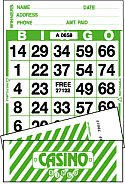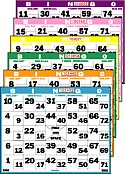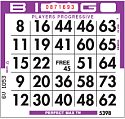Bingo Session Information
| 9:30 am | Breakfast Session |
| 12:30 pm | Matinee Session |
| 6:15 pm | Mini Session |
| 7:00 pm | Evening Session |
| 9:30 am | Breakfast Session |
| 12:30 pm | Matinee Session |
| 6:15 pm | Mini Session |
| 7:00 pm | Evening Session |
| 9:00 AM – 1:00 AM Daily |
| Bingo Game Guide |
| Bingo House Rules |
| Bingo Odds of Winning |
| Refund Policy |
Paper Bingo is the traditional way to play the game we all know and love. Once you have your dauber, all you need is your bingo books or specials for the specific Bingo session you would like to attend at the centre.
This automated approach to traditional bingo provides players with computer touch screen terminals instead of traditional paper and dabbers. We have 196 terminals where you can play multiple cards by simply following the easy step-by-step instructions on your screen.
Play on Demand (POD) games are electronic quick-play games you can play independently, in between bingo sessions, at intermission, or even during live Bingo games. They’re a fun easy way to play your games, your way, any time.
POD games are played on an eBingo player device, however, unlike traditional bingo, which is played against other players, POD games are played against the computer. The outcomes are unpredictable and the odds of winning never change.


Turbo Challenge Bingo is a fast-paced, shutter-style bingo game played on eBingo terminals during bingo session intermissions. Numbers in Turbo Challenge Bingo are called at a faster pace compare to regular bingo. Players must slide the windows on the terminal screen over the corresponding numbers. The speed of play makes this a great game for experienced players looking for added excitement or new players who want fast-paced fun.
 The game of Bingo is relatively simple to learn. For many of us we learned to play bingo as a child at school or possibly at our place of worship. Conventional 75 number bingo is played with bingo cards that have a grid of five horizontal rows and five vertical columns. The columns are lettered B I N G O from left to right across the top of the grid and each bingo card has five numbers in each row except the center N column which has a “free space” at the intersection of the third row and the third column. Bingo balls individually numbered 1-75 are mixed together and the balls are randomly selected one at a time. As each ball is selected, the number is announced to the players, who dab or mark the corresponding number on their bingo card with a bingo ink marker/dabber. When a player completes a predetermined arrangement of covered numbers on the bingo card, that player yells out “Bingo!” Once the bingo card is verified as being correct, he/she wins the game.
The game of Bingo is relatively simple to learn. For many of us we learned to play bingo as a child at school or possibly at our place of worship. Conventional 75 number bingo is played with bingo cards that have a grid of five horizontal rows and five vertical columns. The columns are lettered B I N G O from left to right across the top of the grid and each bingo card has five numbers in each row except the center N column which has a “free space” at the intersection of the third row and the third column. Bingo balls individually numbered 1-75 are mixed together and the balls are randomly selected one at a time. As each ball is selected, the number is announced to the players, who dab or mark the corresponding number on their bingo card with a bingo ink marker/dabber. When a player completes a predetermined arrangement of covered numbers on the bingo card, that player yells out “Bingo!” Once the bingo card is verified as being correct, he/she wins the game.
In the conventional play of bingo, in order to win the game, a player must cover five spaces in a vertical column, a horizontal row or along one of the two diagonals of the bingo card. The free space in the center of the bingo card allows a player to win with as few as four numbers being drawn. Winning combinations for example, can also include the covering of numbers on the bingo card so that letter symbols are formed such as an X, T or L.
The manager of the bingo game must identify which particular combination or combinations of covered numbers will be the winning patterns for that particular game. It is also popular to play “coverall” or “blackout” games in which all 24 of the numbers on the bingo card must be covered in order for the player to win.
Players purchase bingo cards for use during the bingo session, which creates a pool of money. Winning players receive a pre-announced cash or merchandise prize. Typically, a bingo session includes a number of individual bingo games concluding with a coverall game in which a large prize is awarded.
 Lightning: Lightning games are similar to regular bingo games except the speed of calling is much quicker. Balls are typically called at three-second intervals.
Lightning: Lightning games are similar to regular bingo games except the speed of calling is much quicker. Balls are typically called at three-second intervals.
 Dual Dab: A Dual Dab bingo card contains two numbers per square instead of the standard one number per square. Players mark the square if either number is called during the course of the game.
Dual Dab: A Dual Dab bingo card contains two numbers per square instead of the standard one number per square. Players mark the square if either number is called during the course of the game.
Super Jackpot: A Super Jackpot game is a bingo game run in conjunction with a regular bingo event. The jackpot prize is awarded based on completing a specified pattern (full card) within a designated number of bingo numbers drawn. The designated number starts at 50 and increases from event to event until the $2,000 jackpot prize is won.
Accumulator Game:
 A progressive prize shall be awarded to the first person or persons, achieving the winning combination of numbers within the designated number of calls.
A progressive prize shall be awarded to the first person or persons, achieving the winning combination of numbers within the designated number of calls.
The designated number of calls starts at 50 and increases as the prize grows. The progressive prize starts at a base amount of $1,000 and grows by $50 at each successive bingo event until won, or, until the prize reaches $5000. After the Accumulator progressive prize reaches $5000, the designated number of calls shall increase by one each time the progressive prize increases by $500 respectively. Where the progressive prize is not won within the designated number of calls, a consolation prize shall be awarded to the first person or persons completing the winning pattern. The consolation prize is equal to 50% of the gross revenues up to a maximum of $400.The consolation prize shall continue to be played even if the progressive prize is won.
Bonanza:
 A Bonanza game is a bingo game run in conjuction with a regular bingo event. The first 48 balls are pre-called at the beginning of the bingo event. Players immediately mark the first 48 on their cards. The completion of the bonanza game occurs near the end of the session allowing players to continue buying bonanza cards throughout the regular bingo event. The progressive jackpot amount grows each event by 10% of gross revenue and is won by completing the full card pattern in 50 calls or less. When the progressive jackpot is not won (51 calls or more to complete the pattern) the game continues for a consolation prize equal to 50% of gross revenue.
A Bonanza game is a bingo game run in conjuction with a regular bingo event. The first 48 balls are pre-called at the beginning of the bingo event. Players immediately mark the first 48 on their cards. The completion of the bonanza game occurs near the end of the session allowing players to continue buying bonanza cards throughout the regular bingo event. The progressive jackpot amount grows each event by 10% of gross revenue and is won by completing the full card pattern in 50 calls or less. When the progressive jackpot is not won (51 calls or more to complete the pattern) the game continues for a consolation prize equal to 50% of gross revenue.
When the progressive jackpot amount is won at a particular bingo event then no consolation prize will be awarded. The consolation money from that event forms the starting point (seed money) of the next progressive jackpot amount.
Players Progressive Game
 A Players Progressive prize shall be awarded to the first person or persons achieving the winning combination of numbers within the designated number of 50 calls. When the progressive prize is not won within the designated number of calls, the progressive prize shall be carried over to the next bingo event. The progressive prize shall be calculated at 33.33% of gross revenue derived from Players Progressive card sales (electronic and paper) and shall increase by 33.33% of gross revenues until the maximum prize of $5,000 is achieved. When the Progressive prize has reached $5,000 the 33.33% that was going to the Jackpot will instead grow a Progressive Seed Pot. This Progressive Seed Pot will be the starting point of the next Progressive Jackpot. When the Progressive prize is not won within the designated number of calls, the consolation prize of 33.33% of sales shall be awarded to the first person or persons completing the winning combination of numbers. The consolation prize shall continue to be played for even if the Progressive prize is won. Once the progressive prize has reached the $5,000 maximum, then the following day the designated number of calls will increase by one each day until the Jackpot prize is won.
A Players Progressive prize shall be awarded to the first person or persons achieving the winning combination of numbers within the designated number of 50 calls. When the progressive prize is not won within the designated number of calls, the progressive prize shall be carried over to the next bingo event. The progressive prize shall be calculated at 33.33% of gross revenue derived from Players Progressive card sales (electronic and paper) and shall increase by 33.33% of gross revenues until the maximum prize of $5,000 is achieved. When the Progressive prize has reached $5,000 the 33.33% that was going to the Jackpot will instead grow a Progressive Seed Pot. This Progressive Seed Pot will be the starting point of the next Progressive Jackpot. When the Progressive prize is not won within the designated number of calls, the consolation prize of 33.33% of sales shall be awarded to the first person or persons completing the winning combination of numbers. The consolation prize shall continue to be played for even if the Progressive prize is won. Once the progressive prize has reached the $5,000 maximum, then the following day the designated number of calls will increase by one each day until the Jackpot prize is won.
Toonie Pot Progressive
Prior to the commencement of each Regular Bingo event, a bingo ball shall be drawn from the bingo blower. This number shall be known as the “Indicator Number”. The Indicator Number (bingo ball) shall be clearly shown to all players and returned to the bingo blower. The purpose of the Indicator Number is to alert participating players that the number drawn immediately after the Indicator Number will be the “Toonie Progressive Number”.
The Toonie Progressive Game prize shall be awarded to a player or players achieving the winning combination of numbers. In order to win, a player must have a bingo on the number immediately drawn and called after the indicator number. For example, the indicator number drawn at the beginning of the bingo event is B15. When B15 is called during an eligible game the next number called is the Toonie Progressive Number. This next number is G58 and it completes the game pattern. The player yells bingo and wins both the regular game prize and the Toonie Progressive Prize.
The Toonie Progressive prize is calculated at 65% of the gross revenues derived from the Toonie Pot Ticket sales. When the Toonie Progressive prize is not won, the Toonie Progressive prize shall be carried over and added to the next Toonie Progressive session up to a maximum of $5,000. When the Toonie Progressive prize has reached $5,000, a “Must Go” game shall be played. The designated game on which the “Must Go” game will be played shall be communicated to all players. The Indicator Number is not used in determining the winner of the “Must Go” Toonie Progressive prize. There is no consolation prize in the Toonie Pot Progressive Game.
Break Open Tickets are Charitable Gaming fund-raising tickets commonly known as Nevada Tickets which feature a predetermined ticket count and a definite payout amount. The object of the game is to open the perforated windows on the back of the ticket and match the symbols inside the ticket to the winning combinations on the front of the ticket. The winning Break Open Ticket is turned in for a cash prize.
Seal cards and bingo event tickets are specific types of break open tickets.
 A Seal Card Game is similar to any regular deal of break open tickets containing a predetermined ticket count and a definite payout amount. It is played just like a regular break open game with some key differences that add more excitement to your bingo outing.
A Seal Card Game is similar to any regular deal of break open tickets containing a predetermined ticket count and a definite payout amount. It is played just like a regular break open game with some key differences that add more excitement to your bingo outing.
Seal card games typically have smaller ticket counts, which means they sell extremely fast. Some tickets pay instant cash prizes while other tickets contain sign-up numbers that grant certain players a chance at a secondary prize or prizes. Play continues until all tickets are sold. Once all tickets are sold a flare card (poster) is then opened to reveal the flare cards sign-up number. The player whose ticket sign-up number matches the uncovered flare card sign-up number wins.
Bingo event games bridge the gap between bingo and Break Opens and are an excellent way to add excitement to your bingo game. A bingo event game is, for the most part, played in a very similar manner to a seal card game. Each individual bingo event ticket game has a predetermined ticket count, a fixed prize payout, instant winning tickets and a series of hold tickets. The hold tickets in a bingo event in the game are traditionally Bingo Numbers B1-O75. These hold tickets are held for a larger prize that is paid out after all the tickets are sold – again similar to a seal game.
The main difference is that a bingo event game winner can be determined using the bingo flashboard, the last number called during a bingo game or by using the enclosed seal card. For example, if the event game has 75 hold tickets numbered B1-O75 (one number per ticket), and while playing a regular bingo game the number B5 is the last number called, then the event winner would be the holder of the ticket with B5 printed on it. Once, all the tickets in the event game are sold, the caller will announce in which bingo game the event game will be played and announce how the event winner will be determined.
There are several different styles of Event tickets and this is why they offer so much added excitement to your game:
Event or last number called games:
Dab Games:
Line or horse race games:
Player excitement builds until the moment when the end-of-game winner is announced by combining the excitement of break open tickets & BINGO together in one entertainment experience.